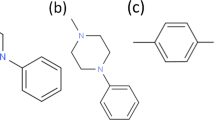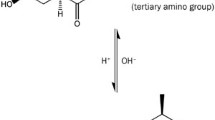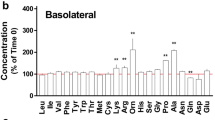Abstract
The Caco-2 model system (Hidalgo et al., Gastroenterology, 96:736–749, 1989), which is a monolayer of polarized intestinal epithelial cells grown onto a porous polycarbonate membrane, was used to study the mechanism of transcellular transport of an antihypertensive agent, L-α-methyldopa (L-α-MD). The results showed that the transport of L-α-MD was pH, glucose, concentration, and temperature dependent, and it could be inhibited by metabolic inhibitors (e.g., 2,4-dinitrophenol) and by amino acids (e.g., L-phenylalanine) which have an affinity for the large neutral amino acid (LNAA) carrier. In addition, the apparent kinetic constants describing the transcellular transport of L-α-MD were altered depending on the time interval between feeding the cells and the transport experiments (postfeeding time, PFT). The apparent maximum carrier flux (J max) of L-α-MD was significantly increased (from 155 to 547 pmol/mg protein/min) when PFT was prolonged from 8.5 to 56 hr. These results indicated that the transcellular transport of L-α-MD through the polarized Caco-2 cell monolayer was carrier mediated via the LNAA carrier. The similarities in the characteristics of L-α-MD transport exhibited by the Caco-2 model system and other intestinal models in vitro further substantiate the usefulness of this cell culture model for studying the intestinal transport of nutrients and drugs.
Similar content being viewed by others
REFERENCES
A. Scriabine. Methyldopa. In A. Scriabine (ed.), Pharmacology of Antihypertensive Drugs, Raven Press, New York, 1980, pp. 43–54.
D. C. Markovitz and J. D. Fernstrom. Diet and uptake of Aldomet by the brain: Competition with natural large amino acids. Science 197:182–190 (1977).
M. D. Day, A. G. Roach, and R. L. Whiting. The mechanism of the antihypertensive action of α-methyldopa in hypertensive rats. Eur. J. Pharmacol. 21:271–280 (1973).
A. Heise and G. Kroneberg. α-Sympathetic receptor stimulation in the brain and hypotensive activity of α-methyldopa. Eur. J. Pharmacol. 17:315–317 (1972).
A. Sjoerdsma, A. Vendsalu, and K. Eagleman. Studies on the metabolism and mechanism of action of α-methyldopa. Circulation 28:492–502 (1963).
K. C. Kwan, E. L. Foltz, G. O. Breault, J. E. Baer, and J. A. Totaro. Pharmacokinetics of methyldopa in man. J. Pharmacol. Exp. Ther. 198:264–277 (1976).
O. Stenbaek, E. Myhre, H. E. Rugstad, E. Arnold, and T. Hansen. The absorption and excretion of methyldopa ingested concomitantly with amino acids or food rich in protein. Acta Pharmacol. Toxicol. 50:225–229 (1982).
W. Y. W. Au, L. G. Dring, D. G. Grahame-Smith, P. Issac, and R. T. Williams. The metabolism of 14C-labelled α-methyldopa in normal and hypertensive human subjects. Biochem. J. 129:1–10 (1972).
J. A. Young and K. D. G. Edwards. Studies on the absorption, metabolism and excretion of methyldopa and other catechols and their influence on amino acid transport in rats. J. Pharmacol. Exp. Ther. 145:102–112 (1964).
I. Osiecka, M. Cortese, P. A. Porter, R. T. Borchardt, J. A. Fix, and C. R. Gardner. Intestinal absorption of α-methyldopa: In vitro mechanistic studies in rat small intestine segments. J. Pharmacol. Exp. Ther. 242:443–449 (1987).
G. L. Amidon, A. E. Merfeld, and J. B. Dressman. Concentration and pH dependency of α-methyldopa absorption in rat intestine. J. Pharm. Pharmacol. 38:363–368 (1986).
A. E. Merfeld, A. R. Mlodozeniec, M. A. Corteses, J. B. Rhodes, J. B. Dressman, and G. L. Amidon. The effect of pH and concentration on α-methyldopa absorption in man. J. Pharm. Pharmacol. 38:815–822 (1986).
D. M. Matthews. Absorption of peptides, amino acids, and their methylated derivatives. In L. D. Stegink and L. T. Filer (eds.), Aspartame: Physiology and Biochemistry, Mercel Dekker, New York, 1984, pp. 29–46.
N. R. C. Campbell, J. H. Dunnette, G. Mwaluko, J. Van Loon, and R. M. Weinshilboum. Sulfate and methyldopa metabolism: Metabolite patterns and platelet phenol sulfotransferase activity. Clin. Pharmacol. Ther. 35:55–63 (1984).
I. J. Hidalgo, T. J. Raub, and R. T. Borchardt. Characterization of the human colon carcinoma cell line (Caco-2) as a model system for intestinal epithelial permeability. Gastroenterology 96:736–749 (1989).
I. J. Hidalgo and R. T. Borchardt. Amino acid transport in a novel model system of the intestinal epithelium (Caco-2 cells). Biochim. Biophys. Acta 1028:25–30 (1990).
G. Wilson, I. F. Hassan, C. J. Dix, I. Williamson, R. Shah, M. Mackay, and P. Artursson. Transport and permeability properties of human Caco-2 cells: An in vitro model of the intestinal epithelial cell barrier. J. Control. Rel. 11:25–40 (1990).
A. Blais, P. Bissonnette, and A. Berteloot. Common characteristics for Na+-dependent sugar transport in Caco-2 cells and human fetal colon. J. Membr. Biol. 99:113–125 (1987).
M. L. Vincent, R. M. Russell, and V. Sasak. Folic acid uptake characteristics of a human colon carcinoma cell line, Caco-2. A newly described cellular model for small intestinal epithelium. Hum. Nutr. Clin. Nutr. 39C:355–360 (1985).
M. Bradford. A rapid and sensitive method for the determination of microgram quantities of protein utilizing the principle of protein-dye binding. Anal. Biochem. 72:248–254 (1976).
H. N. Christensen. Hydrogen-ion dissociation as a factor in amino acid transport. In G. Semenza and E. Carafoli (eds.), Biochemistry of Membrane Transport, Springer-Verlag, Berlin, 1977, pp. 222–234.
H. N. Christensen. Exploiting amino acid structure to learn about membrane transport. Adv. Enzymol. Relat. Areas Mol. Biol. 49:41–101 (1979).
B. G. Munck. Intestinal absorption of amino acids. In L. R. Johnson (ed.), Physiology of Gastrointestinal Tract, Raven Press, New York, 1981, pp. 1097–1122.
B. Steward. Methyldopa. In K. A. Connors, G. L. Amidon, and V. J. Stella (eds.), Chemical Stability of Pharmaceuticals, 2nd ed., John Wiley & Sons, New York, 1986, pp. 573–579.
M. Hu, P. Subramanian, H. I. Mosberg, and G. L. Amidon. Use of the peptide carrier system to improve the intestinal absorption of L-α-methyldopa: Carrier kinetics, intestinal permeabilities, and in vitro hydrolysis of dipeptidyl derivatives of L-α-methyldopa. Pharm. Res. 6:66–70 (1989).
L. R. Finch and F. J. R. Hird. The uptake of amino acids by isolated segments of rat intestine. II. A survey of affinity for uptake from rates of uptake and competition for uptake. Biochim. Biophys. Acta 43:278–287 (1960).
R. P. Spencer and A. H. Samiy. Accumulation of L-phenylalanine by segments of small intestine. Am. J. Physiol. 200:501–504 (1961).
S. Kopf and M. L. Ulmer. Role of unstirred water layer in intestinal permeation. In T. Z. Csaky (ed.), Pharmacology of Intestinal Permeation II, Springer-Verlag, Berlin, 1984, pp. 165–269.
I. J. Hidalgo, K. M. Hillgren, G. M. Grass, and R. T. Borchardt, Characterization of the aqueous boundary layer in Caco-2 cells using a novel diffusion cell. Pharm. Res. 6:S114 (1989) (abstr.).
Author information
Authors and Affiliations
Rights and permissions
About this article
Cite this article
Hu, M., Borchardt, R.T. Mechanism of L-α-Methyldopa Transport Through a Monolayer of Polarized Human Intestinal Epithelial Cells (Caco-2). Pharm Res 7, 1313–1319 (1990). https://doi.org/10.1023/A:1015906409585
Issue Date:
DOI: https://doi.org/10.1023/A:1015906409585




